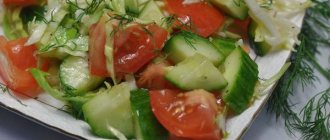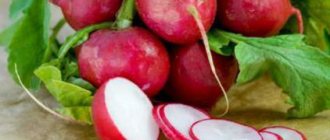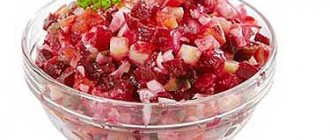Iceberg lettuce
Iceberg lettuce is a vegetable crop related to head lettuce, has light green leaves wrapped in small, not very dense heads of cabbage, juicy and crispy in taste.
Iceberg lettuce has been grown since ancient Egypt, first for its oil and seeds, and only then for its edible, nutritious leaves.
Externally, Iceberg lettuce is very similar to white cabbage, therefore, when buying it in the supermarket in the self-service section, many often confuse them (calorizer). On average, the weight of one head of cabbage is 300-400 g. Iceberg tastes very similar to lettuce, only it has a pleasant crunch, which is completely unusual for the latter. Moreover, the higher the concentration of water in this leafy vegetable, the crispier it is.
Iceberg lettuce calories
The calorie content of Iceberg lettuce is 14 kcal per 100 grams of product.
Iceberg lettuce composition
Iceberg lettuce contains a sufficient amount of folic acid, vitamins C, B, K and A, and choline. In addition, the salad is rich in phosphorus, potassium, sodium and magnesium, and contains calcium and copper. Fiber and dietary fiber, which Iceberg is so rich in, are indispensable helpers for those who want to lose weight by eating tasty and varied foods.
Useful properties of Iceberg lettuce
Iceberg lettuce helps regulate metabolism in the body, improving intestinal motility, and improving blood composition. Thanks to its high folic acid content, Iceberg lettuce helps strengthen the nervous system and helps with stress and emotional disorders. It is recommended to eat Iceberg lettuce during difficult periods of exam sessions and during active mental activity.
During pregnancy, in order to provide the baby with all the necessary vitamins and microelements, expectant mothers include greens and salads in their diet, and Iceberg, which is available all year round, is a favorite.
Since the harm of Iceberg lettuce is minimal, it is recommended to use it as often as you want.
Iceberg lettuce in cooking
Iceberg lettuce is usually consumed fresh, because during heat treatment it loses most of its beneficial properties.
Having a fairly neutral taste, Iceberg will be a worthy “companion” for many products (calorizator). It is used to prepare salads and to decorate appetizers and dishes.
Due to the fact that the leaves of this salad are quite dense and crispy, in cooking they are often used as mini-plates for serving salads and cold appetizers. Iceberg lettuce can be stored in the refrigerator for a long time, because it is the only type of lettuce that is not at all afraid of the cold.
Nutritional value of the product
There are many varieties and types of lettuce. They differ in appearance, leaf color, shape and, of course, ripening time. They are used fresh as a food product, since even the slightest heat treatment destroys vitamins and nutrients.
As a rule, we definitely eat leafy varieties, such as Lollo bioda or Lollo rossa, fresh. But many people often confuse head Iceberg with Chinese or young white cabbage and mistakenly include it in stewed and fried dishes. Indeed, it has soft and juicy leaves with a characteristic crunch, but unlike cabbage, they do not have a pronounced taste or specific aroma. This allows you to combine Iceberg with many other products, using it as a side dish or carving for meat, fish or vegetable dishes.
But many people often confuse headed Iceberg with Beijing or young white cabbage
The low calorie content of greens allows you to diversify your diet and optimize the menu of almost any dietary food.
| Nutritional value of 100 g of product | Composition of vitamins per 100 g of product | ||
| Calorie content | 14 kilocalories | Beta-carotene | 0.299 mg |
| Squirrels | 0.9 g | Vitamin A | 25 mcg |
| Giry | 0.14 g | B1 (thiamine) | 0.041 mg |
| Carbohydrates | 1.77 g | B2 (riboflavin) | 0.025 mg |
| B5 (pantothenic) | 0.091 mg | ||
| Water | 95.64 g | B6 (pyridoxine) | 0.042 mg |
| Monosaccharides and disaccharides | 1.97 g | B9 (folic acid) | 29 mcg |
| Vitamin C | 2.8 mg | ||
| Vitamin E (TE) | 0.18 mg | ||
| Vitamin K | 24.1 mcg | ||
| Saturated fatty acids | 0.018 g | Vitamin PP | 0.123 mg |
| Kholin | 6.7 mg | ||
Calcium - 18 mgIn addition, Iceberg leaves contain a complex of micro- and macroelements necessary for our body:
- Magnesium - 7 mg
- Sodium - 10 mg
- Potassium - 141 mg
- Phosphorus - 20 mg
and:
- Iron - 0.41 mg
- Zinc - 0.15 mg
- Copper - 25 mcg
- Manganese - 0.125 mg
- Selenium - 0.1 mcg
Other types and varieties differ slightly in composition, but their energy value is approximately the same. For example, the calorie content of leaf Lollo biond is not higher than 12 kcal, of Cress salad shoots is 11 kcal, of leaf Lollo rossa is 16 kcal per 100 grams of product.
Iceberg video
Useful properties of Iceberg lettuce
The benefits of Iceberg lettuce for the body are determined by the presence of natural substances in its composition that help maintain health for many years. They are effective helpers for many diseases. This is due to the fact that beneficial properties can:
- increase immunity, strengthen resistance to colds and various infections;
- strengthen the nervous system, helping with stress, relieving depression and emotional disorders;
- reduce the likelihood of atherosclerosis and heart disease;
- positively affect visual acuity by stimulating visual neurons;
- stimulate the removal of toxins, waste and other dangerous substances from the body;
- energize and give a sea of positive emotions.
Therefore, including this vegetable in the daily menu will help in the treatment and prevention of many diseases.
Can I eat Iceberg lettuce while breastfeeding?
It is recommended for nursing mothers to introduce it into the diet when the baby is 1 month old. To do this, a woman should try the vegetable in a small amount in the morning to see the baby’s reaction in the evening. If the baby does not develop a rash or other side effects, then it can be consumed within a day, but in a larger volume.
It is also recommended to drink a healing infusion prepared from the seeds of the culture, the beneficial properties of which will significantly increase lactation.
The benefits and harms of Iceberg lettuce for certain diseases
The health benefits and harms of Iceberg lettuce are determined by its chemical composition. Therefore, it can be used as an adjuvant treatment for certain diseases. Also, the product, in addition to its healing properties, can also cause harm - in this case, it is important to know what health problems you should not use it for.
For diabetes
In order not to cause harm, you need to approach menu planning for diabetes mellitus responsibly. Iceberg lettuce is one of the safest foods for this disease. It can not only diversify the menu, but significantly improve the patient’s well-being due to the presence of a number of useful substances.
For gout
People diagnosed with gout should be careful about eating this vegetable product. This is due to the fact that eating Iceberg lettuce is not recommended for this disease.
For pancreatitis and gastritis
During acute inflammation of gastric diseases, use is strictly prohibited. In addition, the content of cabbage in the diet at this stage is limited. Only when diseases go into remission can the diet be diversified by including Iceberg cabbage, but in minimal quantities. In the future, you should monitor the body's reaction. It is important not to overuse the product for gastritis and pancreatitis.
Possible harm of Iceberg lettuce and contraindications
In addition to its benefits, Iceberg lettuce can also cause harm. Contraindication for use:
- individual intolerance to the components contained in cabbage;
- acute form of colitis;
- urolithiasis disease;
- colitis.
Also, excessive enthusiasm for the idea of losing excess weight and eating vegetables for breakfast, lunch and dinner can cause harm to your health. It must be taken into account that the body needs adequate nutrition and not one product, no matter how useful, is not able to satisfy the needs.
The use of Iceberg lettuce in folk medicine
The beneficial properties of Iceberg cabbage are widely used in folk medicine. This unique vegetable is endowed with a huge range of therapeutic and preventive effects, and therefore arouses interest among traditional healers, as it helps:
- strengthen the body, restore weakened immunity;
- relieve toothache;
- eliminate diseases associated with the genitourinary system;
- find peace of mind even after serious emotional stress;
- ensure good health through quality sleep.
There are many recipes for decoctions and tinctures based on this vegetable. The main thing is not to self-medicate; before taking medications, you need to consult a specialist.
Iceberg lettuce in home cosmetology
Regular consumption of Iceberg lettuce not only helps with a healing course for the whole body, but also maintains youth and beauty when using its beneficial properties for cosmetic purposes. Products based on the product:
- will have a rejuvenating and tonic effect on any skin type;
- restore the firmness and elasticity of the epidermis;
- moisturize dry skin and maintain fat metabolism at the proper level;
- slow down the aging process and smooth out minor wrinkles;
- strengthen hair and give it natural shine and natural beauty;
- eliminate dry scalp by moisturizing and enriching it with vitamins;
- will prevent hair loss.
Application
When buying iceberg lettuce, you need to pay attention to the density of the head. A head of cabbage that is loose inside means that the lettuce is underripe, and one that is too dense, like cabbage, means that the vegetable is overripe. Unlike regular leaf lettuce, iceberg lettuce can be stored in the refrigerator for up to three weeks. Although it does not have a distinctive flavor, iceberg is popular due to the crunchy texture of the leaves. During heat treatment, the vegetable loses almost all its beneficial properties.
Iceberg lettuce is suitable as a base for any salad, as a side dish, or added to sandwiches. Since lettuce leaves hold their shape well, they are often used as plates for salads and appetizers. Before cooking, you need to separate the head of cabbage into individual leaves, and then put them in cold water for a couple of minutes. This makes the leaves even crispier. Then they can be cut into cubes, strips and added to salads.
Market Analytics
- COVID-19 is changing the rules of the game in the cosmetics market
- Beauty of the future: cosmetic innovations 2020
- New ingredients are the driving force of the cosmetics industry
Convenient search for beauty salons on our website
Beauty salons in Moscow Beauty salons in St. Petersburg Beauty salons in Ekaterinburg Beauty salons in Novosibirsk
Latest blog posts on our website
- Naturecream / Geranium (Pelargonium) oil for skin health and beauty
- Prostye-sovety / Save on a beauty salon: procedures that can be done at home
- Naturecream / Growth Factor - brings back youth?
- Oksana-Lezina / 3 effective abdominal exercises from a fitness instructor for beginners
- Prostye-sovety / Making perfect curls at home
- Prostye-sovety / Which hair removal method to choose
- Naturecream / Wrinkles Puppets
- Naturecream / PEPHA-TIGHT - instant skin lifting
- Naturecream / Blue light - a danger to the skin
- Naturecream / Cocoa Butter – A treat for the skin
Latest forum topics on our website
- Mrs._Smith / Badly sunburned! What to do?((
- Ice / Is it necessary to combine fitness classes with a diet?
- Antonova / What can be used for hair loss?
- Radio operatorKat / Who was on a protein diet?
- Suzanna / Mesotherapy on the face
Other articles in this section
| Potatoes Potatoes are the fourth most popular food in the world after rice, wheat and corn. It began to be grown in Central America more than 7 thousand years ago. In the 17th century Potatoes were introduced to Europe, where they soon became the most popular vegetable crop. |
| Boiled carrots At first, carrots were grown as a medicine, not a food product. The ancient Greeks and Romans considered it a strong aphrodisiac. The Roman Emperor Caligula held banquets where only carrots were served in order to arouse “wild lust” among his guests. The Dutch developed a variety of orange carrots; before that, carrots of purple, white, red, yellow, and green colors were grown. |
| Lettuce The Egyptians were the first to grow lettuce many thousands of years ago. At first, oil was made from lettuce seeds, and then they began to eat greens. In Ancient Egypt, this plant was considered sacred. The Greeks and Romans learned about the salad from the Egyptians. In medieval Europe, lettuce was used for medicinal purposes. In the XVI-XVIII centuries. Many different types of lettuce appeared, as it was discovered that cross-pollination was possible between plant subspecies. This leafy green vegetable is rich in vitamins and is often used in cooking. |
| Arracacha Arracacha is a root vegetable of the Umbelliferae family from Latin America, related to carrots and celery. Most common in Brazil, Colombia, Ecuador and Venezuela. The harvest season lasts from January to September. Unlike potatoes, which were brought to Europe from Latin America, arracacha is a very rare vegetable for mid-latitudes. Fruits develop only under certain temperature conditions; root ripening lasts several months. It is very difficult to grow this crop in a continental climate. In Venezuela this vegetable is called “Creole celery”, and in Ecuador it is called “white carrot”. In Brazil, arracacha is grown on an industrial scale. There are several varieties of root vegetables - yellow, orange and white. |
| Onions Onions are often called the “king of vegetables” for their pungent taste. Everyone knows about its health benefits. If you eat a small amount of raw onions every day, you can prevent many diseases, especially colds. |
| Asparagus In ancient times, asparagus was used as an aphrodisiac. In addition to this property, asparagus contains a whole range of nutrients that make it extremely healthy. This vegetable crop began to be grown in Ancient Greece 2500 years ago. It belongs to the lily family, which also includes onions and garlic. This is a perennial plant, and with proper care, asparagus can produce shoots in one place without replanting for 15 years. |
| Lavender Purple lavender flowers with an easily recognizable scent are a symbol of Provence. This plant of the mint family is native to the mountain slopes of the Mediterranean. Since ancient times, lavender has been used as a disinfectant and for flavoring. The scent of lavender has a calming effect. Lavender is an edible plant, although its use is better known for medicinal and cosmetic purposes. |
| Canned eggplant caviar After the famous film “Ivan Vasilyevich Changes His Profession,” the nickname “overseas” was assigned to eggplant caviar, although this dish is little known outside the former USSR. Georgia is said to be the probable homeland of eggplant caviar. Canned eggplant caviar is rich in vitamins and minerals, making it an excellent winter snack. |
| Physalis Physalis is a herbaceous plant of the nightshade family, growing in temperate climates and subtropics. Originating from Latin America, in Mexico alone there are 46 species of physalis. Physalis fruits are a small bright orange berry enclosed in a “papery” cup shell. Physalis is sometimes called ground cherry or golden berry. Wild physalis grows in Russia, but its fruits are inedible and are used only for decorative purposes. |
| Edible colocasia Edible colocasia, or taro, is considered one of the first cultivated plants in human history. This root vegetable is native to Malaysia and India, where it grows wild in dry and humid places. It is a staple food in the cuisine of Africa, India and Oceania. Colocasia is also grown in other countries of the world, including America and southern Europe. Leaves and roots are used for food. In its raw form, colocasia is toxic and requires cooking. |
What can you make from Iceberg lettuce?
Lettuce can be consumed not only fresh, but also used as an ingredient for preparing all kinds of salads, by picking or cutting into small pieces.
Iceberg salad with chicken
A good solution for breakfast would be to cook Iceberg cabbage with chicken, since vegetable fiber is a source of vitamins, and proteins give strength to solve any everyday problems.
- 5 sheets of iceberg lettuce;
- 2 cucumbers;
- 100 g hard cheese;
- 1 chicken fillet;
- 200 g sour cream;
- greenery.
- Boil the chicken fillet and add sour cream, set aside to cool. Then cut into cubes.
- Wash the vegetables, dry and cut into small pieces. Tear the cabbage into equal pieces. Cut the cheese into cubes.
- Stir all prepared ingredients with special care and season with sour cream, in which the fillet cooled, and add salt. Serve on a platter, piled up and garnished with herbs.
This dish should be consumed immediately after cooking, otherwise the Iceberg lettuce will lose its juiciness and will not be suitable for consumption.
Iceberg salad with cherry tomatoes
This dish does not require much time and effort, but it has beneficial properties and a pleasant taste.
- 2–6 iceberg lettuce leaves;
- 150 g cherry;
- 1 bell pepper;
- 1 onion;
- 2–3 tbsp. l. olive oil;
- salt, pepper, depending on taste.
- Dry the washed iceberg lettuce leaves and tear them into small pieces.
- Divide the cherry tomatoes into two parts.
- Remove the seeds and stems from the pepper and chop into strips.
- Peel the onion and cut into thin half rings.
- Combine all prepared ingredients and mix.
- Season the vegetable mixture with salt and olive oil.
- Mix thoroughly again.
Iceberg salad with pineapple
This light, pleasant culinary dish has a special piquant taste that comes from iceberg lettuce. Would be a good option for dinner.
To prepare you need:
- 0.5 fork Iceberg lettuce;
- 4 canned pineapple rings;
- 1 tbsp. l. walnuts and sunflower seeds;
- 4 tbsp. l. vegetable oil;
- 2 tsp. balsamic vinegar;
- salt, pepper as desired.
- Toast nuts and sunflower seeds using a frying pan.
- Dry the washed Iceberg lettuce with a towel and tear into small pieces with your hands.
- Cut the pineapples into small pieces.
- Combine the prepared main ingredient with pineapple, add salt, pepper, vinegar and season with vegetable oil.
- Place the prepared mass on a flat dish and, sprinkle with roasted nuts and seeds, serve.
Diet Iceberg salad with mozzarella without mayonnaise
Components:
- Mozzarella cheese - 100 g;
- bell pepper – 1 unit;
- cherry tomatoes – 5 units;
- green onions - 5-6 feathers;
- Iceberg salad – 200 g;
- olives – 10 units;
- onion – ¼ head;
- salt – 10 g;
- soy sauce, olive oil, sesame seeds - 16 g each.
Sequencing:
- Remove the cheese from the packaging and let dry.
- Peel the bell pepper from seeds and cut into strips.
- Finely chop the onion.
- Cut the tomatoes into halves.
- Cut the mozzarella as desired, leaving a few slices to decorate the dish.
- Dry the olives with a paper towel and cut in half.
- Fry sesame seeds in a dry frying pan until golden brown.
- Chop green onions.
- Mix vegetables and cheese, season with soy sauce, salt and olive oil.
- Sprinkle with green onions and sesame seeds.
- Garnish with a few slices of cheese.
Storing Iceberg Lettuce
Iceberg lettuce cannot be stored for a long time, so it is better to eat it immediately after purchase. It quickly loses its characteristic crunch and begins to fade.
One way to preserve the product longer is to cut it into pieces of the required size and place them in containers made of glass or plastic. Then move to a cool place.
The vegetable can be stored in the refrigerator for 7 days. At higher temperatures, no more than 2 days.
The benefits and harms of Iceberg lettuce lie in its beneficial effect on human health, since the vegetable is able to enrich the body with a mass of biologically active substances necessary for life. Therefore, lovers of this vegetable have good health, peace of mind and a beautiful, slender figure.
LIKED THE ARTICLE. LIKE, SHARE, SUBSCRIBE TO THE CHANNEL AND BE AWARE OF ALL THE MOST INTERESTING AND USEFUL.
Contraindications
Iceberg salad has gained popularity among people who want to lose weight. Nutritionists recommend eating dishes that contain this product. The benefits of salad are obvious, but a sense of proportion should be present in everything. The calorie content of Iceberg per 100 grams is very low, but this does not mean that you need to eat it in kilograms.
The lettuce stem contains latex milky juice, which can have a relaxing effect on the human body. But such exposure leads to a slowdown in metabolism in the body. This provokes the formation of heaviness in the stomach and gases. Under the influence of heat treatment, the substance gains activity, so it is better to eat the salad raw.
Milky juice will be harmful to people who have problems with the digestive system. Or you should remove the stems to save yourself from unpleasant sensations after eating.
Risks and side effects
Many people wonder: is iceberg lettuce safe? Unlike other foods, Iceberg lettuce is almost always eaten raw. The risk of foodborne illness increases because cooking can help kill many harmful pathogens.
Bagged and pre-cut foods are at higher risk of contamination. Therefore, it is often preferable to choose leaf lettuce instead.
Some people are also allergic to lettuce, which can cause severe symptoms, including anaphylaxis. If you experience any side effects after eating lettuce, stop eating immediately and talk to your doctor.
Iceberg lettuce can be considered a healthy food. However, it is important to remember that it is not as rich in nutrients as other types of lettuce. Therefore, it is best to combine it with various green salads and other vegetables to complete your diet.
Storage
The beneficial properties of the product are preserved if it is stored and prepared correctly. Iceberg lettuce is not afraid of low temperatures. Damage will be caused to the structure of the salad if the temperature rises above +90C. If the temperature in the refrigerator is maintained within the range of +20C - +50C, then the leaves will be stored for 7 days. At high temperatures, the salad should remain for no more than 2 days.
Before putting the product in the refrigerator, cut the leaves into pieces. Before doing this, they must be thoroughly rinsed with running water. Place the Iceberg parts into a container and close tightly. It can be stored for no more than 9 days.
If you want to preserve the entire fork, then wrap it with a damp cloth. Place the head of cabbage in the special vegetable compartment. When stored this way, the leaves will remain their natural color and retain their crunch. Thus, the salad can last for 10 - 14 days.








